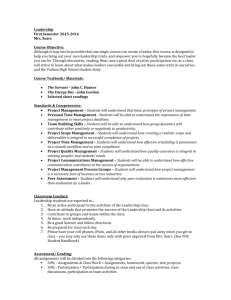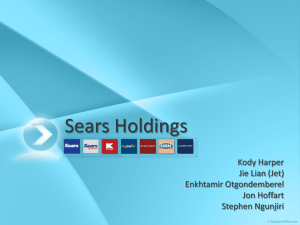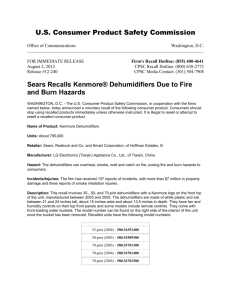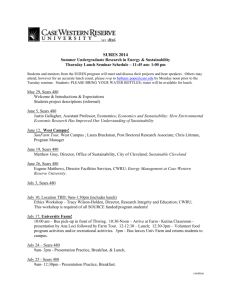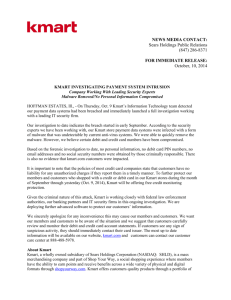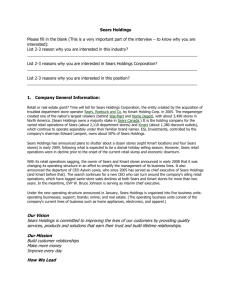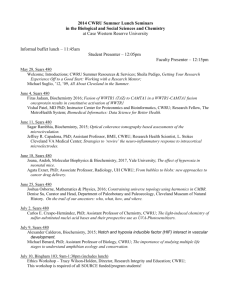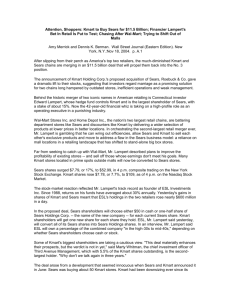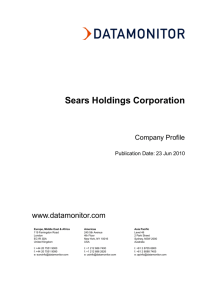Student Handout - Format For Written Case Analysis
advertisement
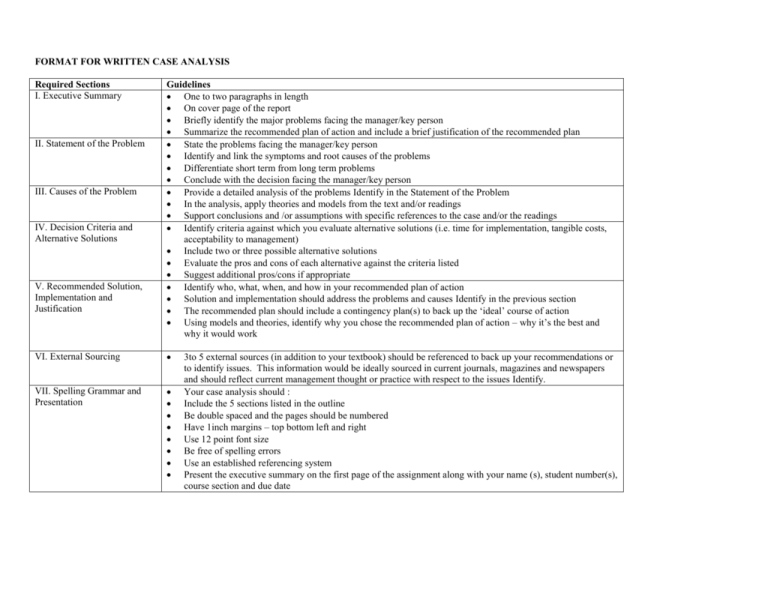
FORMAT FOR WRITTEN CASE ANALYSIS Required Sections I. Executive Summary II. Statement of the Problem III. Causes of the Problem IV. Decision Criteria and Alternative Solutions V. Recommended Solution, Implementation and Justification Guidelines One to two paragraphs in length On cover page of the report Briefly identify the major problems facing the manager/key person Summarize the recommended plan of action and include a brief justification of the recommended plan State the problems facing the manager/key person Identify and link the symptoms and root causes of the problems Differentiate short term from long term problems Conclude with the decision facing the manager/key person Provide a detailed analysis of the problems Identify in the Statement of the Problem In the analysis, apply theories and models from the text and/or readings Support conclusions and /or assumptions with specific references to the case and/or the readings Identify criteria against which you evaluate alternative solutions (i.e. time for implementation, tangible costs, acceptability to management) Include two or three possible alternative solutions Evaluate the pros and cons of each alternative against the criteria listed Suggest additional pros/cons if appropriate Identify who, what, when, and how in your recommended plan of action Solution and implementation should address the problems and causes Identify in the previous section The recommended plan should include a contingency plan(s) to back up the ‘ideal’ course of action Using models and theories, identify why you chose the recommended plan of action – why it’s the best and why it would work VI. External Sourcing VII. Spelling Grammar and Presentation 3to 5 external sources (in addition to your textbook) should be referenced to back up your recommendations or to identify issues. This information would be ideally sourced in current journals, magazines and newspapers and should reflect current management thought or practice with respect to the issues Identify. Your case analysis should : Include the 5 sections listed in the outline Be double spaced and the pages should be numbered Have 1inch margins – top bottom left and right Use 12 point font size Be free of spelling errors Use an established referencing system Present the executive summary on the first page of the assignment along with your name (s), student number(s), course section and due date 2 Natural Design Inc. Case Analysis Check List Use this check list as a tool to define and characterize case findings! Situation Definition 1. Consider current performance, mission, objectives, etc. 2. Considered corporate governance (if applicable) _____ 3. Provide insight with societal trends _____ 4. Provide insight with industry opportunities and threats 5. Identify internal strengths _____ 6. Identify internal weaknesses _____ 7. State strategic factors clearly and concisely _____ 8. Consider both immediate and long term problems _____ Situation Analysis 1. Distinguish between symptoms and underlying problems or causes _____ 2. Distinguish between fact, opinion, and own inferences 3. Recognize all important factors _____ 4. Consider the time frame of the case _____ 5. Avoid excessive rehash of case facts _____ 6. Reflect good understanding of case material _____ 7. Brought in outside information as appropriate _____ 8. Utiliz relevant strategy concepts to aid understanding _____ _____ _____ _____ Alternative Assessment 1. Identify all feasible alternatives _____ 2. Alternatives consistent with situation assessment _____ 3. Evaluat each alternative in terms of risk, cost, timing, etc. as pros and cons. _____ Recommendation 1. Clearly present the recommendation _____ 2. Recommendation follows logically from previous analysis 3. Provide an implementation for recommended solutions, including control procedures _____ _____ See Example Below Case: K-Mart and Sears: Decision to Merge Student Name Business Policy and Strategy - BA490 Date Professor Name 4 Natural Design Inc. Executive Summary The U.S. discount department store industry had reached maturity by the end of the 20th century, but neither Kmart nor Sears possessed clearly-defined positions within that industry. Their primary competitors were Wal-Mart, Target, Kohl’s, and J.C. Penney with secondary competitors in certain categories. Emerging from bankruptcy in May 2003, Kmart still lacked a business strategy to succeed in an extremely competitive marketplace. Its low cost position in discount retailing had been usurped by Wal-Mart. Target now dominated the quality discount position. Sears had a strong position in hard goods, such as home appliances and tools. Nevertheless, Sears was struggling with slumping sales as customers turned from Sears’ mall stores to standalone, big-box retailers, such as Lowe’s and Home Depot, to buy their hard goods. Edward Lampert, Kmart’s Chairman of the Board and a controlling shareholder of Kmart, initiated the acquisition of Sears by Kmart for $11 billion in November 2004 (Hays, 2004). The new company was renamed Sears Holdings Corporation. Even though management predicted that the combined company’s costs could be reduced by $500 million annually within three years through supplier and administrative economies, analysts wondered how these two struggling firms could ever be successful (Securities and Exchange Commission, 2011). Statement of the Problem Both Kmart and Sears illustrate issues in strategy formulation at both the corporate and business level. After many years of retailing success, both companies appeared to have lost their competitive advantage and were forced to merge into Sears Holdings. When comparing Sears’ and Kmart’s to the primary mass merchandising retailing competitors both fell short against to competitors in terms of their individual strengths and weakness. Their competitors are: Wal-Mart, Target, Kohl’s, and J.C. Penney’s, . Macy’s could also be listed as a more distant competitor in mass merchandising, depending upon how one defines the industry. For most of its history, Kmart had successfully followed a corporate strategy of horizontal growth and a competitive strategy of low cost. In contrast, Sears had unsuccessfully followed a corporate growth strategy of concentric diversification out of retailing into financial services in the 1970s, but was forced to retrench through divesting its insurance and real estate units to return to its retailing concentration in the 1980s. Listed below are the strengths and weakness of Sears Holdings (Securities and Exchange Commission, 2011). Strengths of Sears Holdings in 2007 $1.5 billion in cash Debt load of only 25% on total capital on balance sheet Owned real estate assets in good locations Potential cost-cutting economies of scope in purchasing and administrative functions Sears well known for its quality hard goods Weaknesses of Sears Holdings in 2007 Kmart stuck in the discounting middle between Wal-Mart and Target Sears losing its competitive advantage in quality hard goods Stock price fallen from 195 to 111 Deteriorating profit margins and same-store sales Management failed to invest in store improvements Causes of the Problem For most of its history, Kmart had successfully followed a corporate strategy of horizontal growth and a competitive strategy of low cost. By 1990, Wal-Mart had taken over the industry’s low cost position and left Kmart stuck in the middle between Wal-Mart and Target. In contrast, Sears had unsuccessfully followed a corporate growth strategy of concentric diversification out of retailing into financial services in the 1970s, but was forced to retrench through divesting its insurance and real estate units to return to its retailing concentration in the 1980s. Even though its traditional competitive advantage had been its strength in quality hard goods, it had unsuccessfully attempted to grow horizontally in soft goods lines in the 1980s. It found that it could not compete against J.C. Penney’s strength in this area. By the 1990s, Sears discontinued its emphasis on quality soft goods, but soon found that its distinctive competency in hard goods was slowly being eroded by fastgrowing home improvement retailers, like Lowe’s and Home Depot. By 2007, neither Kmart nor Sears appeared to have any sustainable competitive advantage and seemed doomed to be “stuck in the middle” between more competitive retailers. Decision Criteria and Alternative Solutions The primary solution for the two struggling companies K-Mart and Sears is the go through a corporate merger and in order to compete together as one company against retail giant Wal-Mart. In general there are 6 Natural Design Inc. several decision criteria and questions for the two companies to consider. According to marketing professor Barbara Kahn, “The rationale for this merger clearly has to be operations efficiencies, including the ability to compete more effectively against Wal-Mart, which is the leader in that area. The downside would be two struggling companies coming together potentially make a bigger struggling company. At the same time, if the merger is done strategically and wisely, it will provide the scale for the new company to go head-to-head with its toughest rivals. (Knowledge@Wharton, 2005).” The following criteria/questions must be addressed prior to deciding to implement the merger strategy: How could management mitigate the combined stores’ weaknesses and take advantage of any strengths? Would combining the store chains mitigate any weaknesses or improve on any of their strengths? Can the two chains be combined or must they have separate retailing identities? What sort of functional strategies in marketing and operations (including purchasing, logistics, and information technology) might be considered? What corporate and business strategies would get these old U.S. retailing giants growing again? Recommended Solution, Implementation and Justification Both Kmart and Sears bring visible strengths and brands into the merger deal. Kmart is strong in home furnishings and apparel, while Sears is well-known for its appliances. The company should focus on two key strategies while implementing the merger. Key strategies: Focus on a low price strategy. Transform the customer's in-store experience In order to transform the customers experience, the company will need to enhance their capabilities in serving customers by improving in-store execution. To support the low price strategy, the company will have to combine a better cost efficiency, which will support a lower price strategy. References Hays, C. (2004, November 18). Kmart takeover of sears is set; $11 billion deal. Retrieved from http://www.nytimes.com/2004/11/18/business/18shop.html?_r=0 Knowledge@Wharton (2005 , January 14). Sears-kmart merger: Is it a tough sell?. Retrieved from http://knowledge.wharton.upenn.edu/article.cfm?articleid=1081 Securities and Exchange Commission (2011, January 29). Form 10-k: Sears holdings corporation . Retrieved from http://www.sec.gov/Archives/edgar/data/1310067/000119312511062911/d10k.htm

